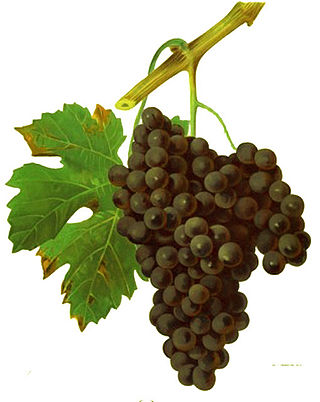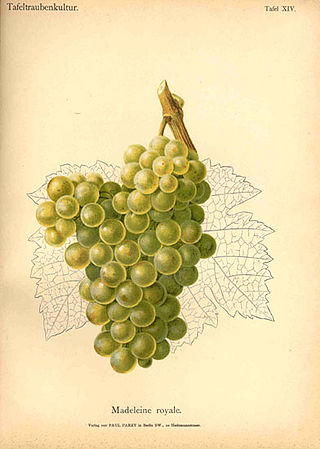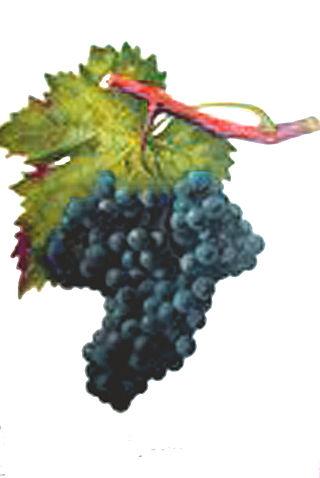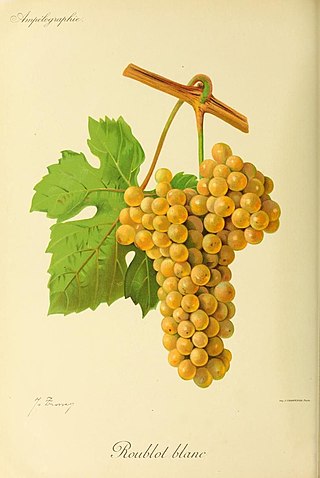
Trousseau or Trousseau Noir, also known as Bastardo and Merenzao, is an old variety of red wine grape originating in eastern France. It is grown in small amounts in many parts of Western Europe; the largest plantations are today found in Portugal, where most famously it is used in port wine. It makes deep cherry red wines with high alcohol and high, sour candy acidity, and flavours of red berry fruits, often complemented - depending on production - by a jerky nose and an organic, mossy minerality.
César is an ancient red wine grape from northern Burgundy. It makes dark, tannic wines that are softened by blending with Pinot noir.

Duras is a traditional French variety of red wine grape that is mostly grown around the river Tarn, northeast of Toulouse. It is usually blended with other traditional varieties, but production has been declining in recent years.
Susumaniello is an ancient variety of red wine grape grown in the province of Brindisi, Salento, Southern Italy.

Madeleine Royale is a variety of white grape. It is mostly grown for table grapes or ornamental purposes, but is notable as a parent of Müller-Thurgau and Madeleine Angevine. It ripens extremely early, in some cases by the 22 July, the feast day of Mary Magdalene, hence the name.
Meslier Petit is a rare white wine grape that is a minor component of some Champagne blends. It is valued for its ability to retain acidity even in hot vintages. In the very rare cases where it is not blended, it makes crisp wines tasting of apples. The Traminer family of grapes can be difficult to grow, with poor disease resistance and low yields.

Argant is an ancient variety of red wine grape. It originated in Spain and may have been taken to eastern France by the Romans. It was briefly popular, but little of it remains today. It used to be common in southwestern Germany and in Austria under the name Gänsfüßer The name refers to the leaf shape, which resembles the foot of a goose.
Bachet noir is a traditional French variety of red wine grape that is a sibling of Chardonnay. A little is still grown in the Aube, where it is used to add colour and body to Gamay wines.

Beaunoir is a traditional French variety of red wine grape that is a sibling of Chardonnay. The 'beautiful black' grape produces a thin wine and not much is grown these days.
Franc Noir de la Haute-Saône is a traditional French variety of red wine grape that is a sibling of Chardonnay. It makes thin, tart wine and has largely disappeared from cultivation.
Gamay Blanc Gloriod is an obscure French variety of white wine grape. Very little of it is grown commercially.
Knipperlé is a traditional French variety of white wine grape from Alsace. It's not listed for use in AOC wine, but is a minor component of blends for local drinking, in some ways an Alsatian equivalent of its sibling Aligoté in Burgundy.

Peurion is a traditional French variety of white wine grape that is a sibling of Chardonnay. Once quite popular, not much is still grown in France these days.

Roublot is a traditional French variety of white wine grape that is a sibling of Chardonnay. It was once quite widely grown near Auxerre.
Dameron is a traditional French variety of red wine grape that is a sibling of Gamay. Its wines are somewhat weightier than Gamay, but it is disappearing from its traditional areas in northern France. Not much is grown in France these days.

Zierfandler is a grape variety used to make white wine in the Thermenregion of Austria. It is also known as Spätrot because it turns red just before harvest time. It is traditionally blended with Rotgipfler but is increasingly being sold as a varietal wine. Zierfandler wines are typically elegant and quite sweet, but with much balancing acidity and a nutty bouquet of pistachios and almonds. They are capable of ageing well.
Schioppettino is a red Italian wine grape grown predominantly in the Friuli Venezia Giulia region of northeast Italy. The grape is believed to have originated between the comune of Prepotto and the Slovenian border, where records of the Schiopettino wine being used in marriage ceremonies date to 1282. The grape was nearly lost to extinction following the phylloxera epidemic of the late 19th century, when vineyard owners decided against replanting the variety in favor of French wine grapes like Cabernet franc, Cabernet Sauvignon, Pinot gris, Sauvignon blanc and Merlot. Some isolated plantings continued to exist until a 1978 European Union decree encouraged its planting in the province of Udine.

Clinton is a red variety of hybrid grape. Its phylloxera resistance led to its being planted in small amounts in the eastern Alps, although it imparts a pronounced foxiness and dark red colour to wine made from its juice.

Rotgipfler is a grape variety used to make aromatic white wine. It is almost exclusively found in the Gumpoldskirchen district of the Thermenregion in Austria. It is often blended with Zierfandler to make Spätrot-Rotgipfler. It is also increasingly used for quality wines. Such Rotgipfler wines are powerful, high in alcohol and suitable for cellaring.
Chasan is a white French wine grape variety grown primarily in the Languedoc wine region. According to the Vitis International Variety Catalogue, the variety is a crossing of Listan and Pinot. However, some sources describe the grape as a crossing between Listan and Chardonnay. All sources agree, however, that the variety was created in 1958 by Paul Truel at the Institut National de la Recherche Agronomique (INRA) - Unité Expérimentale du Domaine de Vassal & Montpellier SupAgro. One possible source for the confusion of the grapes parentage is that a common synonym of several clones of Chardonnay are sometimes listed as Pinot Chardonnay and Chardonnay, itself, was a crossing of Pinot and the obscure French wine grape Gouais blanc.










